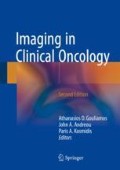Abstract
In this chapter, all the contributors will analyze the latest developments of all imaging modalities that are used today in order to offer the correct information to urologists and oncologists who treat men with testicular cancer. Correct information leads to correct decisions upon further chemotherapy and upon surgical procedures, and all these difficult decisions have the purpose to avoid unnecessary therapies that might hamper the quality of life of our patients.
You have full access to this open access chapter, Download chapter PDF
Similar content being viewed by others
Keywords
- Testicular cancer
- Imaging modalities
- Computerized tomography (CT)
- Magnetic resonance imaging (MRI)
- Positron emission tomography (PET)
1 Diagnosis: Staging
Diagnosis of testicular tumors is performed with ultrasonography (US). MRI of the scrotum has higher sensitivity and specificity than US but should be used in ambiguous cases only. Nodal metastases in the abdomen and in the thorax are performed mainly with CT scans. MRI scans have been used as well and can be helpful in some cases (ambiguous CT findings, allergy to contrast materials), but its wide use in the staging procedure is not justified. PET scans are also not recommended in the staging procedure of testicular cancer [1].
2 Follow-Up Strategies
Follow-up after treatment is being performed with tumor markers and imaging modalities. CT scans are used to evaluate lymph nodes and PET scans are used as well. The main role of FDG-PET, however, lies in the characterization of postchemotherapy residual masses, due to its ability to differentiate between necrosis/fibrosis and residual or recurrent viable tumor. In this context, PET-CT study is recommended in the postchemotherapy management of pure seminoma patients in order to assess whether residual viable tumor is present. In nonseminomatous germ cell tumors of the testis, however, FDG-PET should be used with caution, as it cannot differentiate between mature teratoma and fibrosis [2].
References
Winter C, Pfister D, Busch J et al (2012) Residual tumor size and IGCCCG risk classification predict additional vascular procedures in patients with germ cell tumors and residual tumor resection: a multicenter analysis of the German Testicular Cancer Study Group. Eur Urol 61(2):403–409
Daneshmand S, Albers P, Fossa A et al (2012) Contemporary management of post chemotherapy testis cancer. Eur Urol 62(5):867–876
Author information
Authors and Affiliations
Corresponding author
Editor information
Editors and Affiliations
Rights and permissions
Copyright information
© 2018 Springer International Publishing AG, part of Springer Nature
About this chapter
Cite this chapter
Alivizatos, G.J., Pavlakis, P.A. (2018). Clinical Implications in Testicular Cancer. In: Gouliamos, A., Andreou, J., Kosmidis, P. (eds) Imaging in Clinical Oncology. Springer, Cham. https://doi.org/10.1007/978-3-319-68873-2_86
Download citation
DOI: https://doi.org/10.1007/978-3-319-68873-2_86
Published:
Publisher Name: Springer, Cham
Print ISBN: 978-3-319-68872-5
Online ISBN: 978-3-319-68873-2
eBook Packages: MedicineMedicine (R0)



